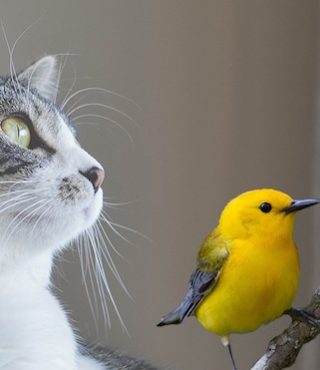A Cat Named Riley Transitioned to Indoor Living and He Likes It Better: A True Story

Part 1: Is outside really more natural than inside?
This blog was written by Kathleen McLeod, Executive Director of our friends and partners at CatsWannaBeCats.Com.
My 76-year-young mother has always kept the company of a cat or two (or five). Every cat she has ever cared for lived the indoor/outdoor lifestyle in rural areas. Keeping a cat strictly indoors had never occurred to her as an option. She, like many others, believed that it’s more natural for cats to be outside and their happiness depended on this belief.
A few years ago, my mom adopted her current lap warmer, Riley. He was found as a stray and my mom was determined to provide him with a loving home and the freedom to leave it whenever he asked.
I have to admit, I grew up with this mentality and allowed my own cats to roam outdoors as they pleased because, well, it pleased them. It took the loss of my own cat to a coyote and years of experience working at an emergency animal hospital to understand the variety of dangers cats can run into in their more “natural” environment. I tried to convince my mom to keep Riley inside by describing all the injuries, parasites, bacterial infections and bite wounds that I witnessed at the animal hospital. The response I had always gotten was some version of, “But he’s happier outside! He would never adjust to staying in!”
Witnessing my own struggle with the guilt and grief over losing my soul-kitty to a coyote and receiving one “Missing Cat” poster after another in the mailbox, my mom decided she wouldn’t risk losing Riley. Approaching me with the latest poster, this time from our next-door neighbour, she asked, “How do we do this?”
I guided my mom through the process of transitioning Riley’s world to the great indoors and made sure that his life would be no less “natural.”
This blog series will take you through Riley’s transition with the hopes of inspiring the guardians of both outdoor and indoor/outdoor cats to create the ultimate indoor experience that any cat would choose over roaming outdoors.
To start, I need to get something out the way…
What is natural?
According to the Oxford Dictionary, when used as an adjective, the meaning of natural is “not made or caused by humankind.” When comparing indoor and outdoor feline lifestyles, the most common argument used to defend the latter, at least in my experience, has been that it’s more natural for cats to be outside where they can run, hunt, scratch and climb. And the impact outdoor cats have on birds and wildlife? Well, that’s just the natural circle of life (A study conducted by Stewardship Center for British Columbia can back it up).
According to the Canadian Encyclopedia: Phoenician trading ships are thought to have brought the first domesticated cats to Europe around 900 BC. Romans are believed to have introduced the cat to England. It was not until settlers arrived from Europe with their domesticated cats that cats were kept as pets in North America.
OK, so humankind had a large part in the domestication of cats as well as their arrival in Canada. And thank goodness! Cats make wonderful companions and they’ve made the internet a happier place!
Canada is home to approximately 9 million domestic cats kept as pets, with just under half allowed to roam outdoors. These cats, along with feral colonies, are responsible for the deaths of up to 300 million birds per year. We have decided to keep these non-native predators as our pets and it’s ultimately up to us whether they go outdoors or not. So, are these bird deaths really the natural circle of life?
Cat parents, don’t leave this blog! You will see that it is written from the perspective of cat health and happiness.
What IS natural? A cat’s instincts are to run, hunt, scratch and climb — humankind can’t take credit for that. Cats wanna be cats! A cat’s natural lifestyle doesn’t depend on whether they spend time indoors, outdoors, or both. It depends on the availability of resources that allow them to behave as their natural felis catus selves.
An enriched indoor environment can be just as satisfying as roaming an outdoor one, if not better! It’s undoubtedly safer, too. I’ll back this up in Part 2 of this blog series.
We want the absolute best for our cats. We love and cherish them and we want them to be with us for as long as possible. If your cat currently spends time outdoors and you’re now contemplating how to keep him indoors without compromising his happiness and ability to “act natural,” stay tuned. I’ll take you through the process that worked for my mom and Riley and help you prepare for your own cat’s transition to a happier and healthier life.








